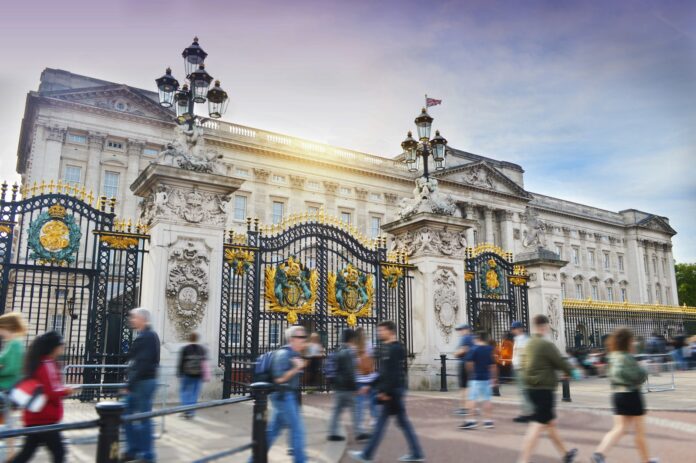Buckingham Palace and the Changing of the Guard ceremony represent quintessential aspects of British culture and history. Located in the heart of London, Buckingham Palace serves as the official residence of the British monarch and a focal point for national celebrations and royal ceremonies. The Changing of the Guard is a symbolic display of military precision and tradition, drawing thousands of visitors daily.
In this article, we’ll guide you through everything you need to know to make the most of your Buckingham Palace & Changing of the Guard Experience, from the historical significance of the palace to tips for enjoying this unforgettable event.
1. The History of Buckingham Palace
Buckingham Palace has been the official London residence of the British monarchy since 1837, beginning with Queen Victoria. However, the origins of the palace date back to 1703, when it was originally built as Buckingham House for the Duke of Buckingham. Over the years, the structure has undergone several expansions and renovations, evolving into the grand palace it is today.
The palace serves as both a private residence for the Royal Family and a venue for state events and official functions. It is from the famous balcony of Buckingham Palace that the Royal Family greets crowds during national celebrations, most notably during the Trooping the Colour ceremony and royal weddings.
2. The Changing of the Guard Ceremony
The Changing of the Guard is one of London’s most iconic ceremonies, attracting millions of visitors annually. It is a formal event in which one unit of the Queen’s Guard hands over responsibility for protecting Buckingham Palace to a new unit. This tradition dates back to the 17th century and has become a symbol of the British monarchy’s longstanding heritage.
A. What Happens During the Ceremony
The ceremony begins with the Old Guard (the soldiers currently on duty) assembling at St. James’s Palace and marching to Buckingham Palace, accompanied by a military band. Upon arrival, the New Guard, also accompanied by a band, marches into the forecourt of Buckingham Palace. Both the Old and New Guards perform drill movements while the handover takes place. The entire ceremony lasts around 45 minutes.
B. Schedule and Timings
The Changing of the Guard typically takes place on Mondays, Wednesdays, Fridays, and Sundays at 11:00 AM. During the summer months (April to July), the ceremony happens daily. However, the schedule can vary, so it’s advisable to check the official Changing of the Guard website for up-to-date timings before your visit.
3. Viewing the Changing of the Guard: Tips for a Prime Spot
Securing a good view of the Changing of the Guard is essential to fully appreciate the spectacle. The ceremony draws large crowds, so it’s recommended to arrive early, especially during peak tourist seasons.
A. Best Viewing Spots
- Victoria Memorial: Positioned directly in front of Buckingham Palace, the Victoria Memorial offers a great vantage point to watch the soldiers march and witness the ceremonial handover.
- The Mall: The wide, tree-lined avenue leading to Buckingham Palace is a prime location for watching the Guards as they march from St. James’s Palace to Buckingham Palace.
- Buckingham Palace Gates: Standing near the palace gates allows you to view the actual guard change within the forecourt of Buckingham Palace. This spot tends to fill up quickly, so arrive at least 30-45 minutes in advance.
B. Pro Tips for an Enjoyable Experience
- Arrive Early: To secure a good spot, aim to arrive by 10:00 AM. The area around Buckingham Palace becomes crowded well before the ceremony begins.
- Use a Map: Download a map of the Changing of the Guard route to better understand where the guards will be marching.
- Check the Weather: The ceremony takes place outdoors, so bring an umbrella or sunscreen depending on the weather forecast.
- Watch the Band: The military band provides a musical accompaniment to the ceremony, often performing both traditional military marches and contemporary tunes. Take time to appreciate the precision of the musicians as they march in unison.
4. Inside Buckingham Palace: Exploring the Royal Residence
From July to October, when the Queen is not in residence, parts of Buckingham Palace are open to the public. The State Rooms are the main areas available for tours and offer a glimpse into the opulence and grandeur of royal life.
A. The State Rooms
There are 19 State Rooms within Buckingham Palace, used by the Royal Family for official ceremonies, receptions, and state banquets. Some of the most famous rooms include:
- The Throne Room: A grand setting used for formal events and ceremonial occasions, the Throne Room is where official photographs are often taken, including those of royal weddings.
- The Ballroom: The largest room in Buckingham Palace, the Ballroom is used for state banquets and large receptions. It is here that foreign dignitaries are entertained during official visits.
- The Picture Gallery: This gallery houses an impressive collection of artwork, including pieces by Rembrandt, Van Dyck, and Rubens.
B. Garden Tours
In addition to the State Rooms, visitors can explore the Buckingham Palace Gardens, which cover 39 acres and provide a peaceful escape in the heart of London. The gardens feature a large lake, wildflower meadows, and beautiful flower beds, offering a glimpse of the natural beauty enjoyed by the Royal Family.
5. Booking Your Buckingham Palace & Changing of the Guard Experience
Visitors can book tickets for Buckingham Palace tours online through the Royal Collection Trust website. For those who wish to witness the Changing of the Guard and explore the palace in one day, various tour packages are available that combine both experiences.
To streamline your visit, consider booking through Viator, where you can find a range of tour options, including guided tours with expert commentary and fast-track entry.
6. London’s Royal Attractions: What to Visit Nearby
Once you’ve experienced the Changing of the Guard and explored Buckingham Palace, there are several other royal attractions nearby that are worth visiting:
- St. James’s Palace: As the former residence of monarchs, St. James’s Palace holds significant historical importance and is still used for official functions.
- The Royal Mews: Located next to Buckingham Palace, the Royal Mews houses the royal collection of carriages and vehicles, including the Gold State Coach used for coronations.
- Westminster Abbey: This iconic church has been the site of royal coronations, weddings, and burials for centuries. It’s a short walk from Buckingham Palace and offers a fascinating insight into British history.
7. Conclusion
The Buckingham Palace & Changing of the Guard Experience is a must for any visitor to London. Whether you’re witnessing the pomp and pageantry of the Changing of the Guard or exploring the opulent interiors of Buckingham Palace, this experience offers a unique glimpse into the traditions and history of the British monarchy.
For more travel insights and in-depth articles on the world’s best destinations, visit Izase, your ultimate guide to lifestyle and travel.
Disclaimer
This guide is accurate to the best of our knowledge, but schedules, fees, and access may change. Please refer to the Viator website for the most up-to-date information and booking details before your visit.
MORE FROM IZASE


